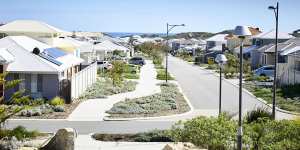Perth’s emissions are a.
About 15 million of these are coming from the built environment – built form,infrastructure,and transport. It matters how we plan and build our city.

Three years to implement the new housing standards is too long,write industry players.Graphic:Kathleen Adele
The Planning Institute Australia declared a climate emergency in 2020. We support reducing greenhouse gas emissions to net-zero by 2050.
It may be late,but big commercial buildings are changing,with national rating system NABERS able to measure carbon impact.
But the same cannot be said of the suburbs.
In Western Australia there is no policy or law to measure the carbon impact of any neighbourhood redesigns.
For the past 12 months,the Planning Institute has been asking the state government to make simple and realistic reforms including legislated carbon reduction goals,strategic plans,precinct-level carbon budgets and individual building performance indicators.
PIA believes specific metrics are essential. To date,the government has responded positively but more is needed. Right now we can’t tell if we are meeting our goals.
We also face a the lifting of energy performance standards for new homes to seven stars as the new 2022 National Construction Code requires.
The 2022 changes will ensure homes are more energy efficient:better insulation,higher quality glazing,smarter floor plans – but the WA Department of Mines,Industry,Regulation and Safety has extended the implementation period until May 2025.
This will continue poor outcomes for vulnerable first-home owners with little influence on how their homes are built.
We also need complementary outcomes in the transport network. Well designed higher density suburbs with good pedestrian and cycling networks will reduce overall car demand,but will also require complementary,safe,accessible public transport.
The rebuilding – – of our city should be treated with urgency.
These changes may not be as onerous and confronting as is sometimes suggested. The delay in uptake of the new construction code in a number of states is a prime example of the resistance to change from some quarters. Others in the planning and development world,including some of the more successful players,are taking a leading role...
Adrian Fini – Hesperia
I launched Hesperia Property with Ben Lisle in early 2020.
Hesperia – “western land” – works only in WA,across sectors including industrial,health and residential. We deliver all projects according to principles including 100 per cent renewable energy and net zero overall climate impact.
Hesperia focuses on adding value to built-up areas with underused infrastructure,not on continuing sprawl. We reinforce infrastructure with renewable energy systems,transport network improvements and electric vehicle charging.
Renewable energy now makes economic sense,although we recognise that with the change,so we’re working to bring energy storage into our systems.
We do detailed modelling of projects’ emissions,reducing wherever possible then offsetting. We address what we can control:carbon released in construction and in the materials supply chain.

Light-coloured roofs are stipulated in Lendlease’s Alkimos Beach community.Supplied.
We plan to move away from offsets as low-carbon materials become available. Meanwhile,we look for offsets involving revegetation or other additional benefits,in collaboration with First Nations groups.
There are challenges,particularly because we are often in joint ventures. But so far we’ve found our partners supportive.
It’s also attracted new partners who set a high bar,such as the Clean Energy Finance Corporation,a major investor in our Roe Highway Logistics Park project. We have also launched a renewable energy business. But the most important benefit is that for many staff,Hesperia’s values align with theirs.
Hesperia is not alone. Major players such as Lendlease,known in WA for sustainability demonstration project Alkimos,are on the journey and have a target of “absolute zero” (no carbon with no offsetting) by 2040.
But even developers like us struggle if larger WA home builders discourage customers from building in our estates. They may do this if they feel our requirements are too onerous – requirements we see as simply good-practice housing performance and quality.
Our lead must be followed for Perth to achieve net zero.
The state government could address this with regulation.
Regulators must stop listening to those who feel they benefit from the status quo and understand all most want is space to innovate and a level playing field. Adopting the NCC sooner would be a start.
There is no evidence setting minimum standards to reach net zero will slow the industry or disadvantage the vulnerable. We’d suggest quite the contrary.
Delivering better housing for West Australians is not too much to ask.
Follow WAtoday on,, and for handpicked selections of the day’s biggest local,national and international news.